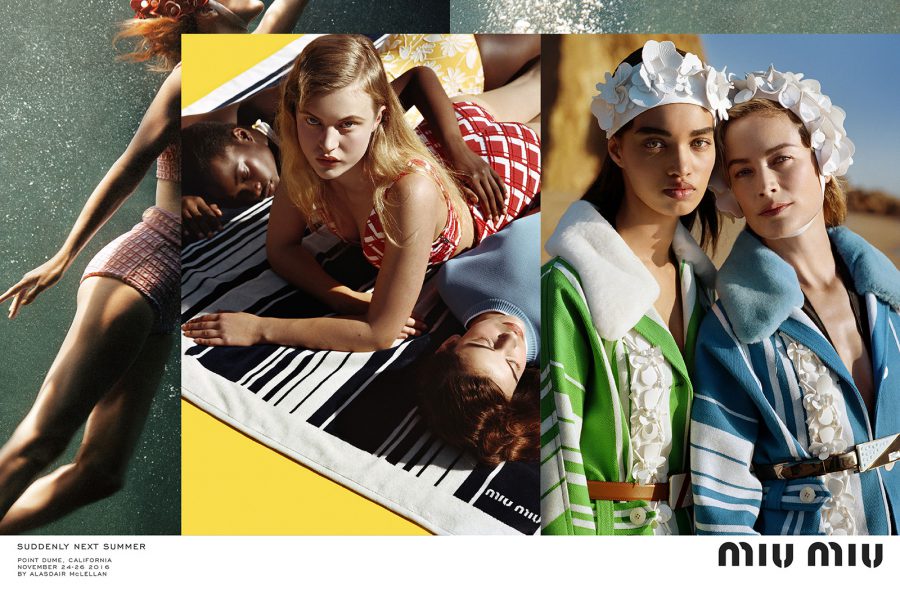International Women’s Day feels like the right time to sit back and reflect on my decision to turn my body into a business. From my first modelling job at 15, to my current role as face of Miu Miu’s summer campaign, it’s been a whirlwind of a ride.
There have been risks, losses, and huge payoffs – and above all, I’ve learnt a lot about my ‘economic’ worth, and how much I’m willing to sacrifice for my career.
When I was 15 years old I started working, and making my own money, as a ‘new face’ back in my hometown, Stockholm. The phrase is industry lingo and refers to all the youngsters who, each year, take a first step (or stumble) into the modelling industry. You know, that glorious world of champagne breakfasts, luxury traveling, tastefully nude black-and-white pictures of avatars leisurely posing with lion cubs in Vogue etc.? Money should be pouring in from day one, no? … Not really.
Don’t get me wrong. The money was there, and some of the jobs I did during that first year as a model payed for things I could have never before dreamt of doing. At that age and time, for example, being able to treat not just myself - but friends and family - to a movie or dinner out, with money that I’d made, was brilliant.
But everything comes with a price. For instance, choosing work over social stuff, I had to let go of that familiar #FOMO (Fear of Missing Out) that haunts most teens pretty quickly – the 'opportunity cost' of having a career so young. My life quickly turned into a constant balancing act in which agents, friends, teachers and family all had to be kept up to date with how I’d chosen to structure my weeks. I no longer 'spent' time, I gave it.
Still, I knew that (a) I was fortunate enough to get a good amount of modelling jobs on a regular basis, and (b) that I could – albeit at the price of social sacrifice and the occasional let-down – use my job to build up economic stability.
So I decided to set up some goals. And some rules.
As a model, your body is your business. Your looks and personality become your 'Unique Selling Point – so keeping healthy is crucial.
Up until that point, questions of what it really meant to be healthy, and whether it was possible in line with the hip/waist/bust measurements that my job (supposedly) required, were things I’d never thought about. Being brought up as a Scandi kid, no-one ever really spoke about health in relation to specific body measurements.
Unfortunately, a 'healthy model’ - regardless how you/I/we feel about it - will still, ultimately, have to be somewhere between the sizes of 0 (32) and 6 (36) in order to be classified as a model in the first place.
I realized that the only way for me to keep sane and professional would be to distance my own conception of health from what the industry expected – drawing the line at the extent to which I'd allow the industry to determine my self-worth. The economics of being a model isn't just about the money – it's about your body, and I had to see to my non-model-self first.
Secondly, although some models see a full-time career in front of the camera or on the runway as their goals, others don’t. In my case, I have to admit that although my job can sometimes feel like a dream, it was never my dream to model. If it were to become a long-term occupation, I'd have to assess the sacrifices I'd have to make to my entire lifestyle – and whether the career was worth the cost.
Again, I was back at the sacrifices vs. gains board. Models never ‘clock off’. Your most valuable currency as a freelancer is availability. Even at 15, reconciling this with the other goals I didn’t want to let go of– university, and travel – was only possible by thinking of my modelling career as a stepping stone towards them, providing me with the funds I needed to make them happen. Defining what it is to be a successful model is hard, especially as it often gets muddled up with concepts of wealth or fame or visibility; giving myself a sense of direction helped me clarify what – to me – would count as success.
It took me a good few years of unpaid jobs, sleepless weeks of work, flight-studying and homesickness to eventually get there. The ‘money clients’, I was taught, won’t call until they’ve seen your face in a sufficient amount of prestigious, non-paying editorials (i.e. magazines).
Then again, thanks to my job I know how to declare taxes in seven different countries, met some of my best friends, and managed to build up the courage and funds to pursue the two main goals I set out as a teenager. And although the fashion industry as such doesn’t necessarily give a damn about these things - “the show must go on” pretty much sums up the vibe – I know the fantastic people I’ve met in it, do.
I still need to remind myself to see to my own health, before adhering to any demands from work. And I still worry about missing lectures over jobs, and vice–versa. But I am lucky enough to call the industry that gave me a chance to grow tall enough to reach those initial goals of mine, a home away from home.




